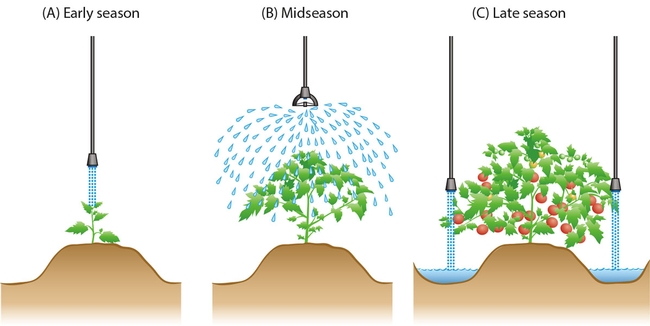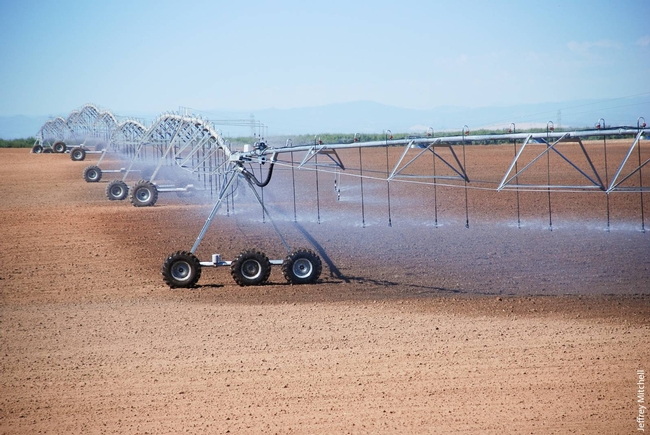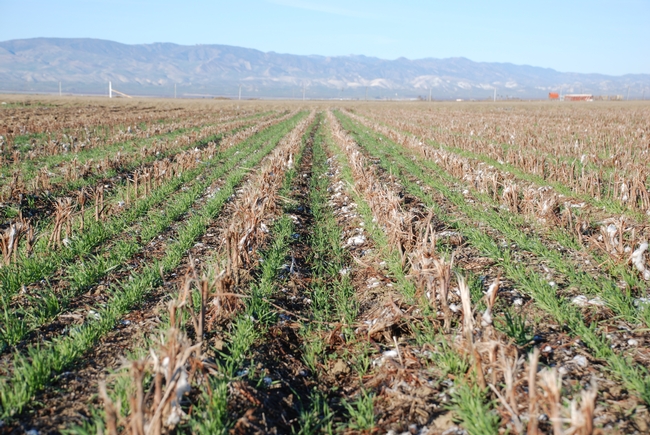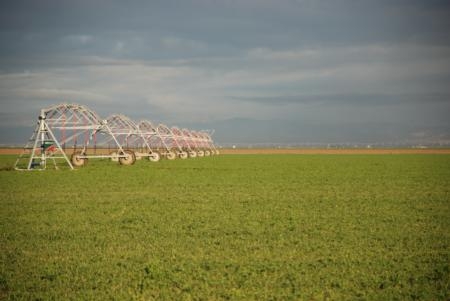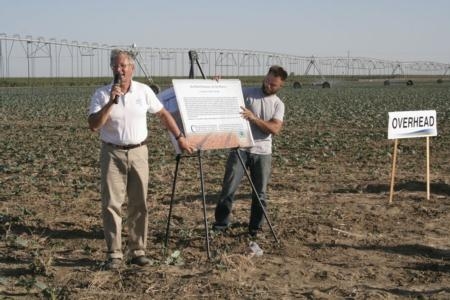Posts Tagged: CASI
Overhead irrigation holds water-saving potential for California farms
In California, 40 percent of agriculture is still irrigated by pouring water onto farmland, a much less efficient practice that drip and overhead irrigation. But those numbers are changing, reported Matt Weiser on Water Deeply.
Weiser interviewed UC Cooperative Extension cropping systems specialist Jeff Mitchell about the water-saving potential of using overhead irrigation, a system that is popular in other parts of the nation and world, but only used on 2 percent of California farmland. Mitchell was the primary author of a research article in the current issue of California Agriculture journal, which said that water and money can be saved using overhead irrigation in production of wheat, corn, cotton, onion and broccoli.
Mitchell said California researchers are looking more closely at overhead irrigation because they anticipate future constraints on agriculture, including water and labor shortages. Additionally, the system is ideal for combining with conservation agriculture systems, which include the use of cover crops, leaving crop residue on the soil surface and reducing tillage disturbance of the soil. The combination of overhead irrigation and conservation agriculture practices reduces water use, cuts back on dust emissions, increases yield and improves the soil.
Weisner asked how overhead irrigation could be as efficient as drip, when people typically see "water spraying everywhere from these roving sprinklers high off the ground."
Mitchell said farmers use pressure regulators and a variety of nozzles on hoses hanging down from the system to deliver water at precisely the rate and location where it is needed through the season.
"So, they're not spraying water. These are low to the ground, and there are various delivery nozzle practices that can be used," Mitchell said.
Researchers see more overhead irrigation in California’s future
That is beginning to change.
UC Cooperative Extension and Fresno State agricultural production scientists researched overhead irrigation at the UC West Side Research and Extension Center for five years, growing wheat, corn, cotton, tomato, onion and broccoli and comparing them with crops produced under furrow and drip irrigation. With all of them except tomato, overhead irrigation led to similar or increased yields, according to the scientists' report published in the current issue of California Agriculture journal.
“Overall, we are very encouraged by these results, and they reflect the experiences that many California farmers have recently been having with overhead irrigation systems,” said lead author Jeff Mitchell, UC Cooperative Extension specialist. “We've confirmed that overhead irrigation systems work in California. We also concluded that there are opportunities to get even better results with more research and experience, particularly when overhead irrigation is coupled with practices that preserve crop residues and rely on reduced tillage.”
The article co-authors are Anil Shrestha, weed scientist at Fresno State; Joy Hollingsworth, UCCE staff research associate; and Dan Munk, Kurt Hembree and Tom Turini, UCCE advisors in Fresno County.
The tomato yields under overhead irrigation were disappointing, particularly since tomatoes have a prominent role in many Central Valley annual crop rotations.
“This isn't a simple process,” Mitchell said. “You can't just turn it on and let it go. It will require focused and dedicated farmer and researcher attention and innovation to solve.”
The authors are working with a team of Central Valley tomato farmers, processors, irrigation experts and research colleagues to improve overhead irrigation management in tomatoes. They are encouraged by the success of Walnut Grove farmer Michael Boparai, who achieved profitable processing tomato yields with overhead irrigation.
Overhead irrigation systems were invented more than 60 years ago. They now irrigate 50 percent of total U.S. farm irrigated acreage. In Nebraska, 87 percent of irrigated land is under overhead systems. By contrast, in California overhead systems irrigate only 150,000 acres, just 2 percent of the state's irrigated farmland.
Mitchell and his co-authors outlined several factors that contributed to its slow rate of adoption in California:
- Early adopters ran into serious problems, giving the systems an undeserved bad reputation that persists even though in recent years California farmers are using the systems successfully.
- Center pivot systems typically leave the corners of the field unirrigated, which can reduce production.
- Purchase and installation cost of the overhead system is substantially higher than furrow irrigation.
However, the UC and Fresno State research has shown many advantages.
- Overhead irrigation can be managed remotely and automatically.
- The system can accommodate different terrain and soil types.
- Overhead systems requires less maintenance than drip systems in terms of avoiding clogging of emitters and repairing leaks.
- Overhead irrigation may also help with salinity management by uniformly leaching salts from a crop's root zone.
- Precision irrigation, including overhead systems, are becoming ever more critical with coming groundwater regulations, surface water cuts and the increasing cost of water for farmers in California.
A significant advantage of overhead irrigation is its compatibility with other farm management technologies that optimize the farming system and reduce costly inputs, including water, fuel, labor and fertilizer.
“We're committed to continuing our work on the whole package – reduced tillage, preserving residue, improving water infiltration, improving soil water-holding capacity and increasing productivity uniformity – a system that we refer to as conservation agriculture,” Mitchell said. “We are working to encourage adoption of conservation agriculture in crops where viability of the system is well established, and facilitate the research and innovation needed to optimize conservation agriculture production in additional crops.”
No-till agriculture has substantial benefits for Central Valley residents
Despite the many benefits of no-till agriculture - including water conservation, improved soil health and reduced dust - the concept is still a "hard sell" in California, reported Ken James in Comstock's Magazine.
The article featured a number of California farmers who sang the praises of the no-till farming method.
- "We definitely save money through higher production, less water usage and lowered equipment and fuel costs," said Modesto farmer Jesse Sanchez
- "We started in 1985 using the no-till method, and since then we've doubled our yield potential," said Fritz Durst, a Yolo County farmer
- "I not only get great production, I save a great deal by not buying expensive tilling equipment, and I look to double my production in times of little rainfall because no-till increases the water-storing capacity of the soil," said Michael Crowley, a Turlock farmer
UC Agriculture and Natural Resources (UC ANR) conservation agriculture expert Jeff Mitchell said the slow implementation of no-till in California is "largely a matter of our farmers not being familiar with no-till practices."
Tillage became popular in California in the 1930s. The agricultural systems developed in the state were wildly successful.
"Because they worked so well, and were so profitable, nobody has felt they should make a change," said Mitchell, who is a UC ANR Cooperative Extension specialist based at the UC Kearney Agricultural Research and Extension Center.
Mitchell is chair of the Conservation Agriculture Systems Innovation Center, a group of farmers, researchers, USDA scientists and ag industry professionals who are working together to spread the word about and encourage adoption of no-till production. Key CASI messages were shared in the Comstock article.
“Since water does not evaporate as quickly in no-till fields, savings in water cost are easy to determine,” Mitchell said. “In addition, fewer pesticides are often needed and farmers also save money by the diminished need to buy the expensive tilling equipment and to pay people to run them.” He adds that soil in the fields, no longer exposed by the tilling, remains richer in its biodiversity and can sustain higher yields. Compaction of the soils, caused by the heavy tilling equipment, is reduced.
Drought is driving interest in high-tech irrigation systems
Allan Fulton, UC Cooperative Extension advisor for Glenn, Shasta and Tehama counties, said technology is improving the ability to organize crop data and get it to farm managers on the fly.
"With the right system," Fulton said, "farmers can get almost to-the-minute information on every aspect of their crop."
As new, integrated database systems are being created, new data-gathering equipment also is advancing for field use to further aid on-farm decisions, the article said. For example, the California Department of Food and Agriculture announced last week a $286,000 grant to UC Davis for work on a continuous leaf moisture monitoring system. Using thermal infrared sensors along with environmental sensors that measure ambient temperature and relative humidity, wind speed and incident radiation, the system's goal is to detect crop water status to support irrigation management.
Jeff Mitchell, a UCCE specialist in the Department of Plant Sciences at UC Davis, is evaluating overhead, or center pivot, irrigation technology, especially in a system that includes conservation tillage. The research is being conducted at the UC West Side Research and Extension Center in Five Points with equipment donated by industry.
The work group focuses on emerging crop- and soil-management techniques — conservation tillage, high-surface residue preservation, cover crops — to improve irrigation management, increase carbon storage and build soil quality.
"We're developing completely new cropping systems for the valley," Mitchell said, "and these get at the so-called three E's of farming—integration of equipment, economics and ecology."
Kings County farmer Dino Giacomazzi, said growers are thinking in terms of systems these days. Giacomazzi is a founding member of UC's Conservation Agriculture Systems Innovation, a workgroup that Mitchell chairs.
"It's very difficult to put things together piecemeal. Even to get advice about these more advanced systems is difficult," Giacomazzi said.
UC conservation ag specialist is no-till farming's 'Johnny Appleseed'
The untiring leader of the UC Conservation Agriculture Systems Innovation Center, Jeff Mitchell, was compared to the legendary American farming pioneer Johnny Appleseed by the author of The Grist's Thought for Food blog, Nathanael Johnson.
Mitchell, UC Cooperative Extension specialist in the Department of Plant Sciences at UC Davis, took Johnson to research fields and farms to show progress being made toward more sustainable production practices in California row-crop farming. Johnson turned the visit into a 1,300-word feature that included links to conservation agriculture research Mitchell has published in California Agriculture journal.
"There's a soil scientist at Berkeley, Garrison Sposito, who says it may be just once or twice in a century that agriculture has an opportunity to re-create itself in a revolutionary way," Mitchell said. "... I think that's what's happening with conservation agriculture. It's energizing for me to wake up to that every day.”
Mitchell and his colleagues are proponents of four tenants of conservation farming:
- Don't disturb the soil
- Maximize the diversity of plants, insects, fungi and microbiota
- Keep living roots in the soil
- Keep the ground covered with plant residues
Mitchell took the writer to the UC West Side Research and Extension Center in Five Points to see research plots that have been farmed continuously with conservation techniques. The beds "have not been worked in 15 years," Mitchell said. “There's more organic material going into the soil, more carbon and more nitrogen. There's more capture of water, and the shade and residue reduces soil water evaporation.”
As the years passed, the soil improved. Instead of the farm equipment needing to break up clots of compacted soil, the researchers found they were planting into soft, fine-grained earth, continuously tilled by worms and roots and microorganisms.
Mitchell learned that residues and no-till practices can reduce irrigation water needs by 16 percent, as well as cut down dust emissions and store extra carbon in the soil.


